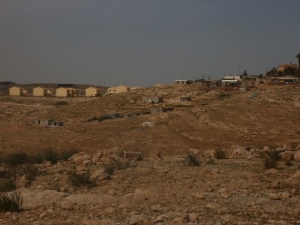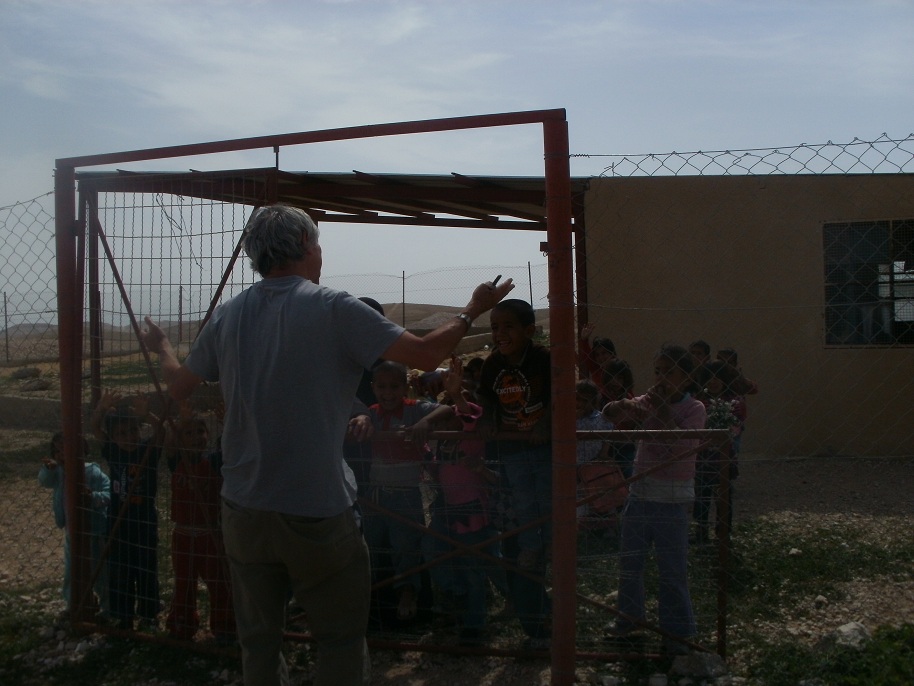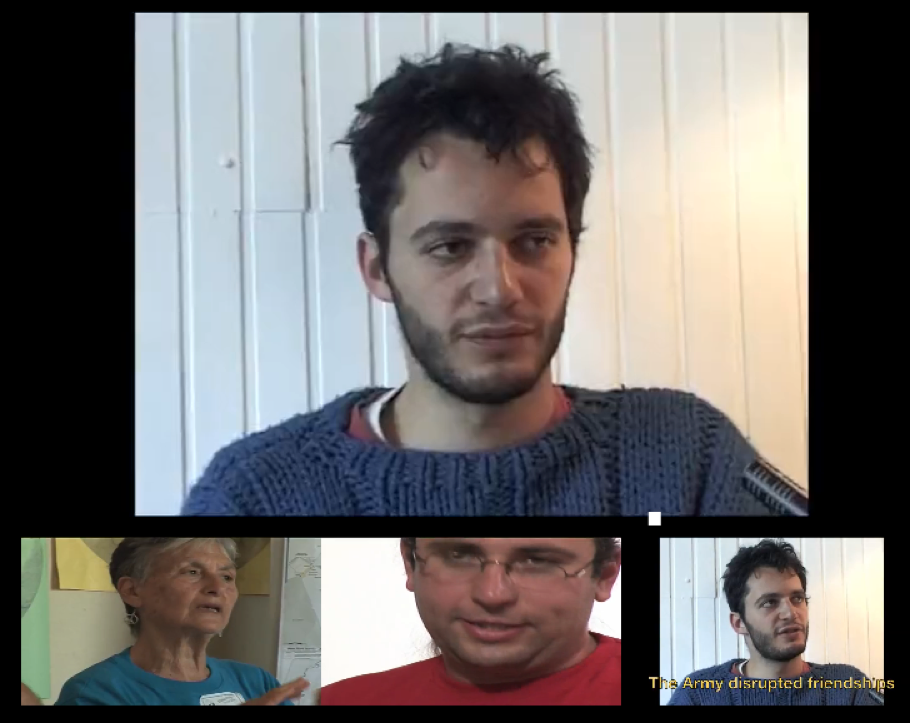The Only Democracy? » On The Ground Reports » Word and Picture Diary: South Hebron Hills Weekly Visit, April 5 2012
Word and Picture Diary: South Hebron Hills Weekly Visit, April 5 2012
(this diary by Ehud Krinis is crossposted from the Villages Group blog)
As we do every week, last Thursday April 5 2012 we went to visit several Palestinian localities in the South Hebron Hills, with whom we have been in contact for some years now. Two members of our little group – Hamed and Erella – just got back that day from a Britain tour as representatives of the Villages Group. So this week’s small visitor team consisted of Ehud and Danny.
We began with a short visit to the preschool (nursery school) in the Bedouin village of Umm al-Kheir. This preschool, opened nearly a year ago, is located in an old building with several rooms renovated with the aid of UNRWA, close to the Saraya of Umm al-Kheir (a term that during the Ottoman Empire days designated a government structure). Two local teachers run the preschool with about twenty children, and receive their salary through the Villages Group. The preschool has undergone a significant change lately – one teacher is now in charge of the younger children (two-three year olds) in the room used as the ‘bustan’ (pre-preschool), while her colleague is in charge of the older children (four-six years old), in the other room that serves as ‘rauda’, preschool.
From the hill where the Umm al Kheir preschool is located, the young children can see the present and future prospects arranged for them by the Israeli Occupation regime. Heavy equipment is busy developing and expanding the new neighborhood at the nearby Jewish settlement Karmel (Carmel) – a development doubtlessly paid for by the Israeli and American taxpayer. Together with an additional neighborhood planned to emerge soon, the settlement will eventually surround the dwellings in this part of Umm al Kheir from three directions (north, west and south).
 |
 |
This stranglehold is an integral part of the Occupation’s policy. The “Civil Administration”, that regime’s arm supposedly entrusted with providing services to Palestinians, has issued demolition orders on nearly all structures belonging to the Bedouin families living in this part of Umm Al Kheir – including outhouses, sheds etc. Many of these orders have already been carried out. We have written extensively here, both about Umm Al Kheir’s demolitions and about the vicious, discriminatory and fraudulent nature of the “Civil Administration” itself. Well-known literary translator and humanist Ilana Hammerman wrote a feature article about Umm Al Kheir and Karmel, with interviews of both Bedouin and settlers. The article was published a few months ago in Ha’aretz.
From the relatively new preschool at Umm al Kheir, we drove down the road and dirt track winding into the Judean desert for a short visit to the oldest operating preschool in the area. This preschool opened its doors about six years ago, at the Bedouin locality of Hashem al Daraj.
About 30 children crowd into the rickety one-room structure of this preschool together with their teacher, Huda, a native of Umm al Kheir who lives at Hasham al Daraj. Huda has been devotedly running the preschool since its founding, determined to overcome its harsh physical conditions. We first became acquainted with this preschool over two years ago . Since that first visit we took it upon ourselves to raise funds that would ensure Huda of a regular, decent salary, compared to the irregularly-paid pittance she had earned until then. We also connected Huda and her preschool with volunteers from the MachsomWatch organization. They have been coming to the preschool ever since. Jointly with Huda and the artist Eid from Umm al Kheir, The MachsomWatch volunteers hold an arts and creativity workshop for the preschool children every two weeks. Danny’s gesture in the picture show our reluctance to leave Huda’s place where we were so warmly greeted by the children – as we needed to fit visits to other localities into our tight schedule.
In the picture above, the children of Huda’s preschool look out towards the new and much larger building that UNRWA has been erecting for them nearby. Although it is already in an advanced stage of construction, completion is delayed. It is unlikely that the children and their teacher would move in before the end of the summer vacation, when the next school year opens. Much of the credit for the recent progress in constructing pre-school facilities at the region’s Bedouin localities goes to Hamed.
After visiting Huda’s preschool at Hasham Al Daraj, we left the Bedouin part of the South Hebron Hills (the eastern-most part of the region), and headed towards the small cave-dweller hamlet of Tuba. Jewish settlements Maon and Havat Maon had disconnected Tuba years ago from the road to nearby Yatta town. Nowadays access to Tuba is only possible via a much longer roundabout dirt track that leaves the Bedouin area and winds its way over the rocky hills. As we climbed this track in Danny’s jeep, the magnificent sight of the cave-dwelling hamlet area, locally called ‘massafer Yatta’/ ‘massfarat Yatta’ (Yatta’s hinterland) came into view.
After several drought years, the current winter has been relatively wet and the short spring that is about to end has yielded especially beautiful wild-flower expanses and a healthy growth of crops in the small fields scattered along the central track of the cave region. See previous posts describing the general conditions in this region and its hardships.
Tuba is a typical cave-dwellers’ hamlet – in its small population that hardly exceeds a few dozen, the affiliation of its families to larger clans whose life-center is Yatta, the main town of the South Hebron Hills, and in the ongoing, perpetual threat of the Israeli Occupation rule and its agents – soldiers and settlers – over the inhabitants’ lifestyle. Talk of the day in Tuba was the wandering tank that startled the residents out of their night sleep as it lost its way among the wadis of the region, designated by the Occupation authorities as military maneuver zone.
Life in the cave-dwellers area has many typical characteristics. Here we describe two of them: First, the custom of parents and brothers to build toys for the little children by recycling various objects. On our current visit, our camera caught the toy that Ali Awad of Tuba built for his young son, Ism’ail.
Residents of the cave dwelling region, Tuba among them, had lived without electricity or any refrigeration until recently. The local goat-milk cheese is known for its high salinity, a means of preservation for a lengthy period of time without refrigeration. On our visit, we saw blocks of this traditional salty cheese placed to dry near the solar plates installed in Tuba two years ago by the Israeli-Palestinian team of COMET-ME.
COMET-ME is our sister organization. In 2008, renewable-energy experts among Villages Group activists started installing stand-alone solar and wind electricity generators in South Hebron hills communities. A year later, the initiative began to operate independently as COMET-ME, and quickly attained worldwide recognition and support.
Among other benefits, the renewable power units installed by COMET-ME enable residents to increase production and improve the preservation of their dairy products. Unfortunately, the “Civil Administration” has recently threatened to demolish many renewable power installations placed by COMET-ME. About the international struggle now taking place against this travesty, see the organization’s website.
At the end of our Tuba visit, we returned from the caves dwellers area to the Bedouin part and to Umm al Kheir. Unlike the local rural population that has evolved its cave-dwelling lifestyle for centuries, the Bedouins of the region are originally tent-dwellers and do not live in caves. In view of the consistent house demolition policy applied in the part of Umm al Kheir nearest to the Jewish settlement Karmel, a large number of the local residents are forced to continue living in tents. Among others, we visited the tent of the family elder, Hajj Shueib (photographed alongside his youngest daughter Rana and Ehud).
Later we also visited widow Miyaser, whose straw and stones house has been recently demolished by official thugs of our time. Some of you, especially those who support the Villages Group in Durham, Britain, have already had the opportunity to help Miyaser and her seven children by purchasing her embroidery work (in the photograph, Khulud, Miyaser’s daughter, displays her mother’s new embroidery).
Filed under: On The Ground Reports · Tags: Bearing Witness, Friendship, Human Rights, Indigenous Rights, Israel-Palestine, Nature, Picture Diary, Renewable Energy, Solidarity, Spring, Villages Group


















 “You have a choice! Israeli Anti-Militarists Speak”
“You have a choice! Israeli Anti-Militarists Speak”
[…] an evacuation order instructing the settlers to leave by the next day. link to http://www.btselem.org Word and Picture Diary: South Hebron Hills Weekly Visit, April 5 2012, Assaf Oron From the hill where the Umm al Kheir preschool is located, the young children can see the present […]